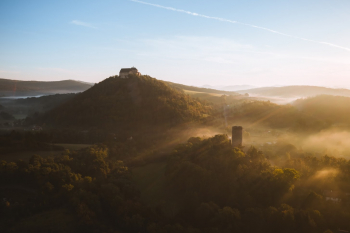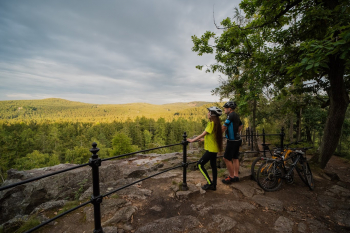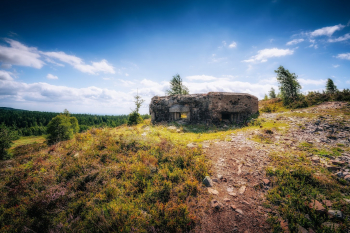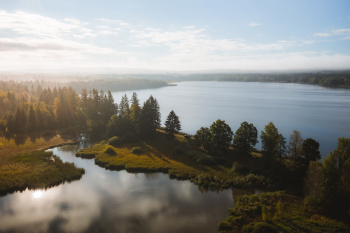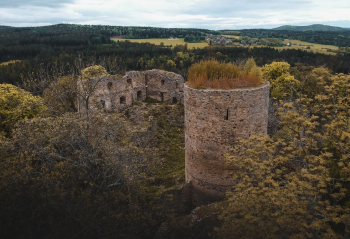Brdy and Podbrdsko
Add to plannerDeep impenetrable forests, breathtaking views and romantic corners. Nature in its purest form and military bunkers from the recent past. Discover Brdy, a long-forgotten area in the heart of Bohemia.
The highest inland mountains
Just outside the town of Příbram lies an area that many of us have not yet had the opportunity to explore. The Brdy Mountains are the only mountains in Central Bohemia and the highest mountains in the Czech hinterland. They are not and never have been permanently inhabited, so even in the twenty-first century they are a deserted mountain island with unspoilt nature. In some places it resembles Šumava, in others the Scottish moors, and elsewhere the wild Scandinavian taiga and tundra. Its integrity is only disturbed here and there by the ruins of a medieval castle or the remains of military activity. It is not for nothing that Brdy was declared a protected landscape area.
Nature in symbiosis with human activity
The hills of Brda are replaced in the foothills by the rural landscape of Podbrdsko with fairy-tale castles and castles and unique technical features that recall the mining and processing of iron, silver, ores and other metals. You will not find such a symbiosis of military and technical monuments with beautiful nature anywhere else.
An ideal destination for short trips and longer holidays
A great advantage of Brda and Podbrdsko is the proximity of large cities. The tourist area is easily accessible by car and train from Prague, Pilsen and České Budějovice.
The area is thus a great choice for an afternoon escape from the grey of everyday life or a Saturday day trip. The many natural, architectural and technical gems also make it an ideal holiday and vacation destination.
Brdy on foot or by bike?
Brdy and Podbrdsko are interwoven with a number of hiking and cycling trails. The passionate hiker, whose goal is to climb as many kilometres and peaks as possible, as well as families with small children or seniors looking for a short walk with a story, can go hiking here. There are plenty of hiking trails of varying difficulty and focus.
Those who prefer cycling will also find plenty to do in Brdy and Podbrdsko. Adrenalin-packed hikes and leisurely rides through nature or sightseeing await you. Both sportsmen and recreational cyclists can choose from a range of cycling routes.
Experiences for children and parents
It would be a shame to give up trips just because you have small children. Children will have unforgettable experiences in Brdy and Podbrdsko that they will remember for a long time. In Příbram, the Mining Museum with its train, slide and underground tunnel exploration will provide such an experience. The Podbrdské castles and chateaux will fascinate with their tours with ghosts or princesses, in the Podbrdské Museum in Rožmital pod Třemšínem children will dress up as a brave knight or try their hand at swordplay.
Following the traces of cannons and planes
Military fans will literally be in seventh heaven in Brdy. The area was used by the army as a training ground for many decades and traces of the military past are still evident here today. The German army built some roads, field airfields, bunkers and operated an important radar on the top of Praha used to navigate Luftwaffe night fighters. The Czechoslovak army built here, in addition to a number of bunkers, observation posts, firing ranges, engineer shelters, garrison quarters and their facilities, a highly strategic underground combat headquarters for the conduct of World War III.
Brdy and Podbrdsko are a year-round destination
You can come to Brda and Podbrdsko for a trip or holiday at any time of the year. From spring to autumn you can enjoy nature and sights, in summer you can cool off in the shade of the Brda forests or at the swimming pool. You can also add a tasting of products from one of the local breweries.
In winter, you can discover the views that remain hidden behind the leaves of the trees and bushes. On foot or on cross-country skis, it's up to you.
Which places you shouldn't miss in Brdy
If you want to explore the former artillery landing sites and bunkers with your own eyes, but at the same time enjoy the beautiful views and visit the most valuable sites of the Brdy Protected Landscape Area, you should go to the highest mountain of Brdy, Tok, the nearby Houpák Hill and the former Jordán landing site. This can be done in one hike along the hiking trail with the characteristic name Dělostřelecká, which starts in the village of Obecnice.
Cycling connoisseurs can follow a similar, but challenging, route called Heart of the Brda Mountains. It offers even more attractions and starts just outside Příbram, specifically at the Podlesí brewery.
For a more leisurely route in the saddle of your bike, plan a ride to the icons of the Brda region, the Padrta Ponds. You start from Rožmital pod Třemšínem. Apart from the natural scenery, you will certainly be struck by the turbulent fate of local villages that had to give way to the expansion of the military area.
The most famous castle ruin in Brdy is Valdek. It was described as deserted as early as the 16th century. Valdek was a popular destination during the national revival. It inspired the works of Karel Hynek Mácha and Božena Němcová. Today, visitors are attracted by the many myths and legends associated with the castle. The most famous is the one about the White Lady of Valdec, who asked travellers to come to her at night and rescue her from her enchantment. In return, she promised a part of the treasure supposedly hidden in the castle. Entrance to the castle is forbidden, but the opposite Jindřichův skála (Henry's Rock), the largest in Brdy, offers a nice view. You can go to Jindřichova skala as part of a bicycle tour called From the valley of iron to the most beautiful viewpoints. As you can see, the route offers a number of truly magnificent views. It starts and ends in Komárová on the square.
For more information about the Brdy and Podbrdsko Tourist Area and many other tips for trips, visit www.brdyapodbrdsko.cz.

